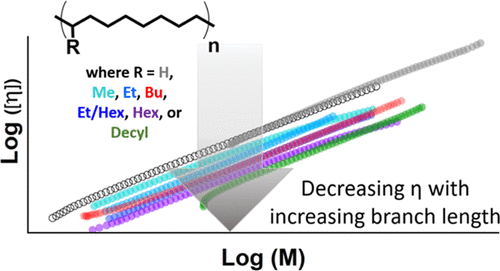当前位置:
X-MOL 学术
›
Macromolecules
›
论文详情
Our official English website, www.x-mol.net, welcomes your feedback! (Note: you will need to create a separate account there.)
Design and Characterization of Model Linear Low-Density Polyethylenes (LLDPEs) by Multidetector Size Exclusion Chromatography
Macromolecules ( IF 5.5 ) Pub Date : 2020-03-27 , DOI: 10.1021/acs.macromol.9b02623 Sara V. Orski 1 , Luke A. Kassekert 2 , Wesley S. Farrell 1 , Grace A. Kenlaw 1 , Marc A. Hillmyer 2 , Kathryn L. Beers 1
Macromolecules ( IF 5.5 ) Pub Date : 2020-03-27 , DOI: 10.1021/acs.macromol.9b02623 Sara V. Orski 1 , Luke A. Kassekert 2 , Wesley S. Farrell 1 , Grace A. Kenlaw 1 , Marc A. Hillmyer 2 , Kathryn L. Beers 1
Affiliation

|
Separations of commercial polyethylenes, which often involve mixtures and copolymers of linear, short-chain branched, and long-chain branched chains, can be very challenging to optimize as species with similar hydrodynamic sizes or solubility often coelute in various chromatographic methods. To better understand the effects of polymer structure on the dilute solution properties of polyolefins, a family of model linear low-density polyethylenes (LLDPEs) were synthesized by ring-opening metathesis polymerization (ROMP) of sterically hindered, alkyl-substituted cyclooctenes, followed by hydrogenation. Within this series, the alkyl branch frequency was fixed while systematically varying the short-chain branch length. These model materials were analyzed by ambient- and high-temperature size exclusion chromatography (HT-SEC) to determine their molar mass, intrinsic viscosity ([η]), and degree of short-chain branching across their respective molar mass distributions. Short-chain branching is fixed across the molar mass distribution, based on the synthetic strategy used, and measured values agree with theoretical values for longer alkyl branches, as evident by HT-SEC. Deviation from theoretical values is observed for ethyl branched LLDPEs when calibrated using either α-olefin copolymers (poly(ethylene-stat-1-octene)) or blends of polyethylene and polypropylene standards. A systematic decrease of intrinsic viscosity is observed with increasing branch length across the entire molar mass distribution. This work demonstrates the applicability of these model materials to deconvolute structure–property relationships using chromatographic separation techniques and is a step toward determining if sequence control can minimize compositional heterogeneity and generate improved standards for determining branching content in commercial polyolefins.
中文翻译:

利用多检测器尺寸排阻色谱法设计模型线性低密度聚乙烯(LLDPE)
商业聚乙烯的分离通常涉及线性,短链支链和长链支链的混合物和共聚物,由于具有相似流体动力学尺寸或溶解度的物质在各种色谱方法中经常共洗脱,要进行优化可能非常困难。为了更好地理解聚合物结构对聚烯烃稀溶液性能的影响,通过空间受阻的烷基取代的环辛烯的开环易位聚合(ROMP),然后再合成一系列模型线性低密度聚乙烯(LLDPE)氢化。在这个系列中,烷基支链频率是固定的,同时系统地改变了短链支链的长度。通过环境和高温尺寸排阻色谱法(HT-SEC)对这些模型材料进行分析,以确定它们的摩尔质量,特性粘度([η])和在它们各自摩尔质量分布上的短链支化度。基于所使用的合成策略,短链支链在整个摩尔质量分布上是固定的,并且测量值与较长烷基支链的理论值相符,如HT-SEC所示。使用两种α-烯烃共聚物(聚乙烯(乙烯- 如HT-SEC所示,测量值与较长烷基支链的理论值一致。当使用两种α-烯烃共聚物(聚乙烯(乙烯- 如HT-SEC所示,测量值与较长烷基支链的理论值一致。使用两种α-烯烃共聚物(聚乙烯(乙烯-Stat -1-辛烯))或聚乙烯和聚丙烯标准品的混合物。随着在整个摩尔质量分布中支链长度的增加,观察到特性粘度的系统性降低。这项工作证明了使用色谱分离技术将这些模型材料用于反卷积结构与性质之间的关系的可行性,并且是确定序列控制是否可以使成分异质性最小化并为确定商业聚烯烃中的支化含量提供改进标准的一步。
更新日期:2020-04-24
中文翻译:

利用多检测器尺寸排阻色谱法设计模型线性低密度聚乙烯(LLDPE)
商业聚乙烯的分离通常涉及线性,短链支链和长链支链的混合物和共聚物,由于具有相似流体动力学尺寸或溶解度的物质在各种色谱方法中经常共洗脱,要进行优化可能非常困难。为了更好地理解聚合物结构对聚烯烃稀溶液性能的影响,通过空间受阻的烷基取代的环辛烯的开环易位聚合(ROMP),然后再合成一系列模型线性低密度聚乙烯(LLDPE)氢化。在这个系列中,烷基支链频率是固定的,同时系统地改变了短链支链的长度。通过环境和高温尺寸排阻色谱法(HT-SEC)对这些模型材料进行分析,以确定它们的摩尔质量,特性粘度([η])和在它们各自摩尔质量分布上的短链支化度。基于所使用的合成策略,短链支链在整个摩尔质量分布上是固定的,并且测量值与较长烷基支链的理论值相符,如HT-SEC所示。使用两种α-烯烃共聚物(聚乙烯(乙烯- 如HT-SEC所示,测量值与较长烷基支链的理论值一致。当使用两种α-烯烃共聚物(聚乙烯(乙烯- 如HT-SEC所示,测量值与较长烷基支链的理论值一致。使用两种α-烯烃共聚物(聚乙烯(乙烯-Stat -1-辛烯))或聚乙烯和聚丙烯标准品的混合物。随着在整个摩尔质量分布中支链长度的增加,观察到特性粘度的系统性降低。这项工作证明了使用色谱分离技术将这些模型材料用于反卷积结构与性质之间的关系的可行性,并且是确定序列控制是否可以使成分异质性最小化并为确定商业聚烯烃中的支化含量提供改进标准的一步。


























 京公网安备 11010802027423号
京公网安备 11010802027423号